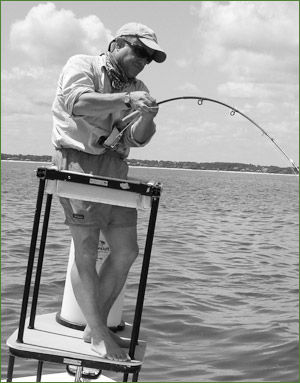
My very first tarpon trip more than humbled me; I felt like a neophyte angler that couldn’t cast a fly more than 20 feet, and even then I wasn’t close to my quarry. Bonefishing was no different; calm days when tails are up and you can see the water shake 100 yards away weren’t the norm.
So, take it from me who learned the hard way—before going on your first flats trip, or any saltwater trip, practice, practice, practice before your trip. Don’t wait until you get there. Here are some things I recommend that big trip:
- Practice on windy days, and cast with the wind in your face and from odd angles. You never know when you’re in the flats boat which way the wind will be blowing. The guide will always try to position the boat as best as possible, but at times shots are quick and you want to be ready regardless of wind direction.
- Use a target when you practice. I like to use a hoop, but any target on the lawn or a pond will work. Move out to many different distances, close, far, and in the middle; wind in your face, and a cross wind that challenges the drift of the fly before it hits the water. If you can master this at home with a stiff wind, your chances of hooking up on the flat will be greatly increased.
- Use various fly weights and bulk when practicing. This is critical. A heavy fly won’t turn over as easily as a lighter fly, nor will a big bushy fly flow through the wind as easily as a sparse Charlie. If you use a heavy lead eye permit fly on a 9 foot leader into the wind, trust me, they’ll make you feel inadequate unless you know what it feels like to cast it before you get there. I can’t tell you how many times the guide’s recommendation was a heavily weighted crab fly that I didn’t have in the box, and became a challenge to cast on my rod. So don’t only practice with the easy flies, try them all, including the heavy and bulky.
- For rods, don’t go under-gunned. If you can take a second rod, go up a line weight, not down. An 8-wt rod is best for bonefish, but bring a 9-wt with you for a really challenging day of wind; you’ll be glad you did. And that’s important. There are a lot of guides and fisherman that will go lighter in rod weights. If this is your first trip, you don’t want to take a lighter rod for bonefish. Fortunately, the New Zero Gravity saltwater rods are the lightest, best-balanced saltwater rods made; so you can cast them longer with far less fatigue than any other rod. A 9-wt truly feels like a six weight in hand.
- A tip flex rod keeps a tighter loop on windy days. Although I’m a mid flex caster, I make sure to have a tip flex rod when the wind picks up. It allows me to control my loop, to make it as small as possible. A big loop catches wind, a small loop exposes little of the line to the wind and casts farther, more accurately. In order to maintain that small loop, you’ll need to concentrate on your casting stroke.
- Another trick is to over-line your rod. If you have an 8-wt rod and you encounter a really windy day, put a 9-wt line on a back up reel for the rod. You’ll find it loads easier, and it tends to punch and turn over flies in the wind better than the 8-wt line. Some anglers might say, “go to a smaller line, there’s less diameter to be affected by the wind.” The reason I say go larger is the biggest impediment is the fly you’re turning over, and a lighter line will only make it more challenging. There are casters who can control a smaller diameter line, but for most of us, the larger line weight will help turn over the fly, and punch more into the wind.
- Wind is a challenge: concentrate. Adding the excitement of seeing a 150lb tarpon, or that tailing permit only makes it worse. One of the hardest things to do is to slow down and concentrate on making the cast that you know you can make. I’ve seen great casters crumble when confronted with that tarpon. Slow down and think about your cast. It’s not easy but the calmer you remain as you begin your cast the more successful you’ll be in delivering the fly in challenging conditions.
- Flyline is important too. In most situations you’ll typically fish a floating line. It picks up easier than an intermediate or a sinking line and allows for maybe one more crucial cast to a fish. Sinking or intermediate lines have a smaller diameter but the same mass as a floating line, making them easier to cast into the wind. But you may lose that extra cast.
- Keep your flyline clean. A clean line will always perform better than a dirty one. A dirty line sticks to guides, especially in the wind. So keep a line cleaning kit with you, too.
Use these tips and your next trip to the flats, especially if it’s your first, will be more enjoyable.




